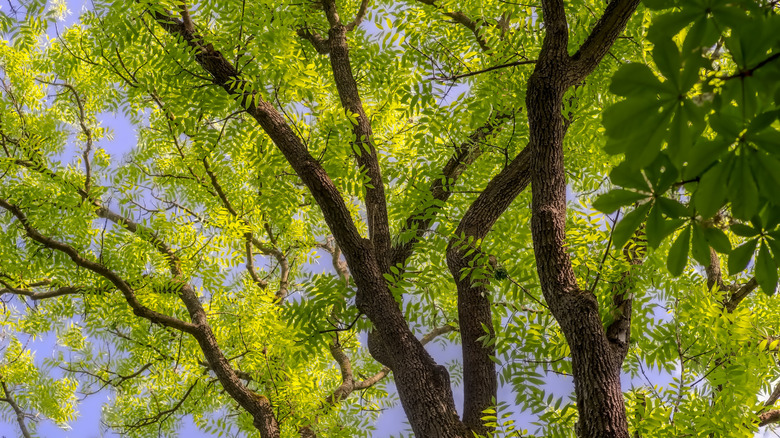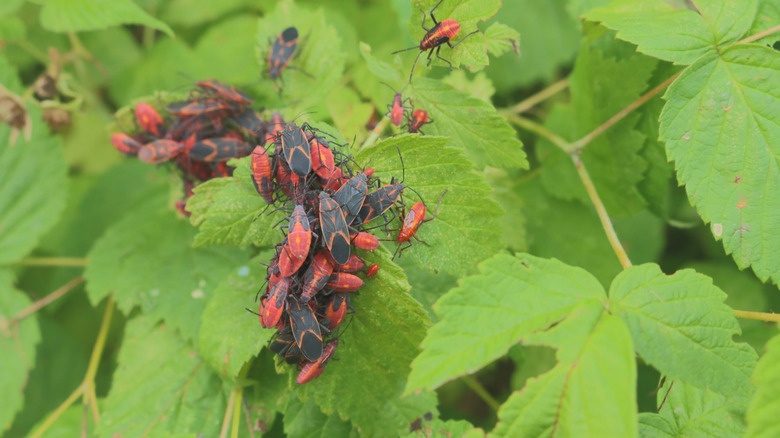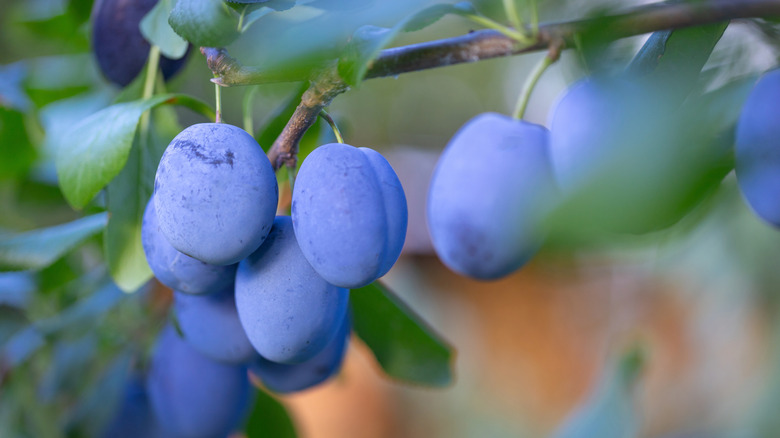10 Plants That Are Attracting Unwanted Boxelder Bugs To Your Yard Or Garden
Boxelder bugs, who count stink bugs and cicadas among their cousins, might be drawn to certain plants and trees in your garden. You could be unintentionally inviting them in with cherry, plum, or maple trees, and even strawberries. Boxelders have dramatic black and red markings on their backs, along with red eyes. These pests tend to be active from the spring through the fall, when swarms pile up on sidewalks or branches to absorb some sun.
Boxelders can look intimidating, but they don't bite humans. Most of the time, they cause minimal damage to plants compared to other common garden pests. Of course, bumper crops of boxelders brought on by warm weather or drought might start to have an effect. And sometimes, when cool weather settles in during the fall, those boxelder bugs might try to move indoors with you where it's warm. If you step on them, you're in for an unpleasant surprise. The smell is almost as bad as stinkbugs when they're smashed.
These insects are named for their very favorite meal of all – the boxelder maple tree. The pest is one of the most prominent maple tree bugs out there. Boxelders also snack on certain vegetables and fruit. If you want to keep your yard free of the black and red bugs, then you might want to rid yourself of these 10 plants that may be attracting boxelders to your yard.
If you don't want boxelder bugs, then avoid planting their namesake
The number-one plant a boxelder bug wants for a meal happens to be the tree it's named after: The boxelder maple (Acer negundo). Specifically, they like to target female trees that grow the seed pods. Don't bother to spray the trees with pesticides to try to get rid of them, either, since boxelders can fly high up in the sky to avoid them. There is some good news, though. These insects won't kill actually kill your boxelder trees, unlike termites or other more invasive bugs.
Boxelder bugs like cherries almost as much as we do
Boxelder bugs don't just feast on their beloved boxelder maple pods — they'll also snack on cherry (Prunus avium) trees, too. Since it's not their favorite meal, they might not get quite as many needed nutrients as they do from boxelder maples, which can (luckily?) affect the next generation of boxelders. To know if you've got boxelders, look for signs of withered fruit in the tree, since the bugs poke through the skin of fruit or seed pods (kind of like a mosquito for fruit) and suck out sweet juice.
If boxelder bugs can't find a maple, they'll go for an ash tree
Ash trees (Fraxinus spp.) definitely attract boxelder bugs, since it can be among their favorite places to dine. These trees feel at home in highly populated areas, which could be luring boxelder bugs into the neighborhood and tempting them to invade your house. Keep in mind that even if they do set up shop indoors, they don't build nests there like some other pests, because they don't breed, lay eggs, or multiply inside. Also, they don't even eat in the winter, so your pantry's safe.
Boxelders will snack on raspberries
Don't be surprised if you see hoards of boxelder bugs on raspberries (Rubus idaeus). They like these berries just as much as we do. Boxelders will often pile on top of each other in swarms on leaves, pavement, or even the sides of your garage in search of warmth in cooler weather. The bugs can manage to live through cold weather huddled together to keep warm. While just a few boxelder bugs aren't much to worry about, swarms of them can suck raspberries dry. They might even drop from the vine before they're fully ripe.
Strawberries might also bring in boxelder bugs
Strawberries (Fragaria x ananassa) might be attracting boxelder bugs, too, since the bugs have been known to feed on these berries. Who can blame them for also liking this sweet fruit? Fun fact: Since they can suck up juice from fruit, boxelders don't need to find water to drink. They get enough fluid when they eat like this. These bugs will be easy to spot on the strawberry plant's green leaves.
Almond trees can attract boxelder bugs
Some people might love a handful of almonds for a snack, but so do boxelder bugs. They'll head to an almond tree (Prunus dulcis) if a maple isn't around, which is certainly an interesting fact about the almond tree. Boxelders even been known to eat their fair share of almond crops if they come in large numbers. But if you're hoping that boxelders can take on other pests, though, you're out of luck. They stick purely to plants and do not hunt other insects.
Sweet potatoes might also be on a boxelder bug's menu
Boxelder bugs also might be drawn to sweet potatoes (Ipomoea batatas). Of course, the bugs aren't likely to eat the potato, which we like to do. They're much more likely to munch on the leaves and stems that grow above ground, which are easier to access. Of course, in order to produce mature sweet potatoes, the plant needs its green leaves to thrive — which is why this could be an issue if you want your plants to stay pest-free.
Boxelder bugs might lay eggs on plum trees
While female boxelders prefer laying eggs in a boxelder maple, they've also been known to lay eggs in a plum (Prunus domestica) shrub or tree. The eggs hatch in early summer and then the young bugs or nymphs will feed on the sweet juices of the fruit or its leaves. It's worth mentioning that while you may find nymphs, or young boxelders, on these trees — they're not likely to do serious damage to your plums.
Grapes might draw in boxelder bugs
Grapes aren't just good for making wine. They might also be attracting boxelder bugs. These insects will eat this fruit if their other preferred trees aren't around. But because boxelder bugs normally aim to eat fruit of the grape plant, it usually means there's no serious sustained damage to the plant's foliage. Boxelders aren't picky and can be found in a variety of different types of grape vines. If you grow grapes, you may have seen a boxelder bug or two before.
Pistachio trees sometimes invite boxelders
Pistachio trees might also attract boxelder bugs to your yard. If you've got a real infestation, you can cut the tree down, but this likely won't fix the problem long term, since boxelder bugs can simply escape by flying to their next meal. Boxelders don't like water, and young nymphs drown easily. Using your garden hose to spray them off branches might be surprisingly effective. Boxelders are less harmful than other kinds of pests, so ultimately you might even decide just to live with them.










